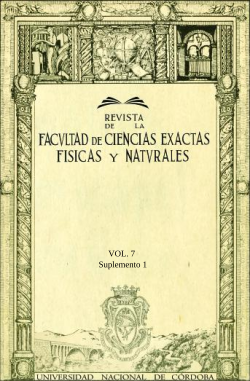La geología de Théodore Pavie
Keywords:
South America, explorers, 19th century, illustrations.Abstract
Pavie was born in Angers, France. He arrived to Montevideo in 1833. From there he went to Buenos Aires. He traversed the Pampa to Cordoba, San Luis and Mendoza. He crossed The Andes to Santiago de Chile, then went to Valparaiso and finally to Lima. He returned to Europe in 1834. He composed drawings of the Cerro de Montevideo, the coast of the La Plata estuary in Buenos Aires showing its terraced levels, and a view of the mouth of the Riachuelo with the La Punta Island, a geoform that does not exist today. He also made several compositions on the Sierras Pampeanas and, specially, on his trip across The Andes by the Uspallata Pass. His account of the crossing of this mountain range constantly referred to the weather stiffness of the last days of that winter. Pavie’s observations matches well with the historical series of the Mendoza River runoff which indicate that the spring of 1833 and the summer of 1834 was a period of high flow, normally related to the presence of abundant snow. Illustrations of Chile and Peru landscapes complete the compositions.
Downloads
References
[1] Alleman Haeghebaert V. y Pedraza Borja A. (2014), “Traducción con análisis paleontológico de fósiles de la Isla San Lorenzo y Piñonate colectados por el capitán Paul Berthon”, Revista de Ciencias 10: 56-97.
[2] Brogioni N. (1990), “Geología y petrografía del vulcanismo Mio-Plioceno de la provincia de San Luis”, Revista del Museo de La Plata, Nueva Serie, Tomo 10, Geología 90: 197-214.
[3] de Gandía E. (1939), Historia de la Boca del Riachuelo 1536-1840, Buenos Aires, Ateneo Popular de la Boca, 255 p.
[4] Ibañes O. D., Sruoga P., Urbina N. E. y Garro J. M. (2012), “Volcanismo y mineralización asociada en el área del cerro Tiporco, provincia de San Luis, Argentina”, Serie Correlación Geológica 28(1): 145-156.
[5] Jara P. y Charrier R. (2014), “Nuevos antecedentes estratigráficos y geocronológicos para el Meso-Cenozoico de la cordillera Principal de Chile entre 32° y 32°30’S: implicancias estructurales y paleogeográficas”, Andean Geology 41(1): 174-209.
[6] Le Roy Laudrie E., Rousseau D. y Javelle J.-P. (2017), Sur l’histoire du climat en France depuis le XVIe siècle, Trappes, Météo et Climat, Société météorologique de France, 35 p.
[7] Nabel P. y Pereyra F. X. (2002), El paisaje natural bajo las calles de Buenos Aires, Buenos Aires, Museo Argentino de Ciencias Naturales Bernardino Rivadavia, 123 p.
[8] Neukom R., Prieto M. del R., Moyano R., Luterbacher J., Pfister C., Villalba R., Jones P. D. y Wanner H. (2009), “An extended network of documentary data from South America and its potential for quantitative precipitation reconstructions back to the 16th century”, Geophysical Research Letters 36: L12703.
[9] Novoa Farro R. (2011), “Revisión bibliográfica de las trigonias de Lima”, Biotempo 11: 60-63.
[10] Ottone E. G. (2004), “Aimé Bonpland's drawings of the Itá Pucú, 1834, and the history of the early geological representations in Argentina”, Earth Sciences History 23(1): 121-133.
[11] Ottone E. G. (2019), Théodore Pavie, un francés en las pampas, Buenos Aires, Dunken, 226 p.
[12] Oyhantçabal P., Spoturno J., Aubet N., Cazaux S. y Huelmo S. (2003), “Proterozoico del suroeste del Uruguay: nueva propuesta estratigráfica para la Formación Montevideo y el magmatismo asociado”, Revista de la Sociedad Uruguaya de Geología, Publicación Especial 1: 38-48.
[13] Palacios Moncayo O., Caldas Vidal J., Vela Velásquez Ch. (1992), Geología de los cuadrángulos de Lima, Lurín, Chancay y Chosica. Hojas 25-i, 25-j, 24-i, 24-j, Instituto Geológico, Minero y Metalúrgico (INGEM¬MET), Lima, Boletín 43, Serie A: Carta Geoló¬gica Nacional, 163 p.
[14] Prieto M. del R., Herrera R. y Dussel P. (1999), “Historical evidences of streamflow fluctuations in the Mendoza River, Argentina, and their relationship with ENSO”, The Holocene 9: 473-481.
[15] Prieto M. del R. y Rojas F. (2012), “Documentary evidence for changing climatic and anthropogenic influences on the Bermejo Wetland in Mendoza, Argentina, during the 16th–20th century”, Climate of the Past 8: 951-961.
[16] Ramos V. A., Aguirre-Urreta M. B., Álvarez P. P., Cegarra M. I., Cristallini E. O., Kay S. M., Lo Forte G. L., Pereyra F. X. y Pérez D. J. (1996), Geología de la región del Aconcagua, provincias de San Juan y Mendoza, República Argentina, Dirección Nacional del Servicio Geológico, Subsecretaría de Minería de la Nación, Buenos Aires, Anales 24, 510 p.
[17] Sanguinetti A. (1985), Observaciones geológicas en la Cordillera Frontal y en la Precordillera, entre Polvaredas, Potrerillos y Uspallata, pcia. de Mendoza, Tesis de Licenciatura en Ciencias Geológicas, Facultad de Ciencias Exactas y Naturales, Universidad de Buenos Aires, Buenos Aires, 132 p. (inédito).
Downloads
Published
Issue
Section
License
Copyright (c) 2020 Facultad de Ciencias Exactas, Físicas y Naturales (Universidad Nacional de Córdoba)

This work is licensed under a Creative Commons Attribution 4.0 International License.
Los autores que publican en esta revista están de acuerdo con los siguientes términos:
Los autores conservan los derechos de autor y conceden a la revista el derecho de la primera publicación.
Los autores pueden establecer por separado acuerdos adicionales para la distribución no exclusiva de la versión de la obra publicada en la revista (por ejemplo, situarlo en un repositorio institucional o publicarlo en un libro), con un reconocimiento de su publicación inicial en esta revista.
Se permite y se anima a los autores a difundir sus trabajos electrónicamente (por ejemplo, en repositorios institucionales o en su propio sitio web) antes y durante el proceso de envío, ya que puede dar lugar a intercambios productivos, así como a una citación más temprana y mayor de los trabajos publicados (Véase The Effect of Open Access) (en inglés).



